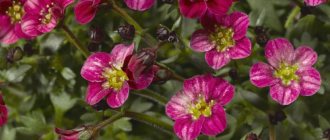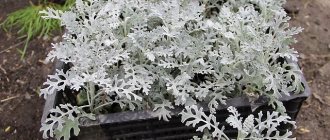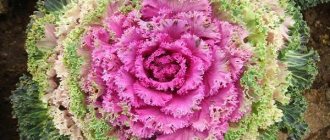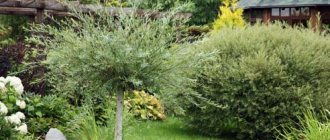Decorative leaves of cineraria, covered with silvery pubescence, create the impression of icing. These spectacular shrubs make excellent compositions with other plants. The article describes in detail the silver cineraria plant - planting and care, presents photos in the garden, tells how to properly grow it in a summer cottage and on a balcony, how it can overwinter, and how to propagate it.
Reproduction, planting and transplantation of cineraria
The methods of propagation of cineraria depend on its species:
- Flowering species reproduce exclusively by seeds.
- Decorative foliage species can be obtained from seeds and cuttings.
- Indoor cineraria can be propagated by seeds and by dividing the bush.
Sowing of seeds of flowering species occurs from December to February. If the seeds were sown in February, the flower will release buds only closer to autumn.
The decorative deciduous species can be sown even in March. Then in May the flower will take on the appearance of a beautiful bush.
Growing from seeds involves the following steps:
- For flowers, select a wide, shallow container with good drainage holes.
- For seeds, prepare special soil consisting of peat and sand in equal proportions.
- The seeds are carefully distributed over moist soil, leaving a distance of about 2 cm between the seedlings. Densely planted flowers will be difficult to pick. After distribution, they are lightly submerged. To do this, you can use a regular stationery ruler.
- The container is covered with film or glass. It is placed in a room with an air temperature of 20℃-22℃.
- Seedlings should be ventilated and the soil sprayed every day. The first shoots will appear after 1.5 weeks.
- The sprouts are planted in peat pots and moved to a cool room with a temperature no higher than 15℃.
- With the onset of stable warmth, the sprouts along with peat pots are transplanted to the site. In open ground they are cared for like adult plants.
Decorative deciduous varieties can be cut from:
- In summer, shoots about 10 cm in length are cut from the flower.
- For better rooting, before planting, they are treated with the drug Kornevin, which stimulates root growth.
- The cuttings are stuck into a damp sand-peat mixture under a cap. If such caps are not found on the farm, they can be replaced with cut-off transparent plastic bottles.
- The cuttings are ventilated and moistened daily.
- After rooting, the caps are removed.
- The shoots remain in sandy-peaty soil until spring.
- For the winter they are moved to a cool place.
- With the onset of warm weather, rooted cuttings can be planted in plots.
Cuttings
The indoor species can be propagated by dividing the bush; this is usually done during transplantation:
Using a sharp sterile instrument, the rhizome of the plant is cut into the required number of parts.
It is very important that each separated part has at least 1 strong stem. The damaged areas are treated with an antiseptic. Each part of the bush is placed in a separate pot.
Indoor flower replanting is carried out in the spring, before the budding process begins. The plant does not need to be replanted annually. It is enough to replace the soil every 2-3 years. The soil for the flower should consist of leaf soil, compost and peat. It is advisable to add a little pine bark and ash there. Medium-sized pots are selected for cineraria.
Garden flowers, which are grown as perennials, are transplanted into a pot every fall and returned to the plots in the spring. Before planting, the soil must be dug up, enriched with a small amount of peat, sand and compost. The holes for cineraria are made shallow, and the flowers themselves are planted at a distance of 20-25 cm from each other. After planting, the soil is abundantly moistened and mulched with peat.
It will also be interesting: Tradescantia Reo - flower care at home and types?
Description of types and varieties of ragwort
Cineraria is the name of a genus of plants belonging to the Asteraceae family. It is close to the genus Krestovnik, so both names are often used. Represented by almost 50 species of various herbs and shrubs , which are perennials. In our latitudes in dachas they are grown as annuals.
The flowers are collected in baskets, and those, in turn, are collected in shields. The variety and beauty of color will delight you not only with the rich tones of the flowers, but also with their interesting pattern: a rich burgundy or lilac border frames the white base. There are also solid white and pink flowers. The green part of the plant is incredibly beautiful and unique - the leaves are of an unusual shape, reminiscent of coral reefs or antlers. The leaves are of unusual shape - rugged, cross-shaped. They have characteristic shades from milky and silver tones to sky blue.
How to sow cineraria (video)
This decorative value makes it possible to use cineraria as a houseplant, as well as in a summer cottage when forming flower beds, rockeries, rock gardens and borders. Different varieties of cineraria are planted together, as well as in combination with other plants - the number of composition options is almost limitless.
Gallery: cineraria (25 photos)
Cineraria silver (seaside)
The variety got its name due to the unusual silver color of the foliage, which creates a very unusual, mysterious atmosphere in the garden. It contrasts well on a lawn or flowerbed and creates an amazing background that goes well with almost any color.
The plant comes from Madagascar and is therefore very light-loving. It is planted only in open places that receive the maximum amount of light. The variety also requires quite abundant watering, especially at the initial stage of growth.
Cineraria silver (seaside)
Cineraria graceful
A distinctive feature of this variety is the stem, which produces wide, powerful branches. The plant is lush, has bright scarlet and purple flowers and is perfect for rockeries, as well as as a decoration for a country path. Inflorescences are most often represented by terry baskets. In the country, it is grown as an annual, although it is most often biennial or perennial.
Since this variety of ragwort grows in width, it is better to plant the plants at least 20-30 cm apart from each other. Most often it is propagated using seedlings, since the variety is very heat-loving and may not take root in unheated soils.
Cineraria graceful
Cineraria bloody
Despite its name, this variety of ragwort has flowers of various shades - along with different tones of red, there are rich blues, purples, scarlets, crimsons and even whites. The greenery has a pleasant, rich color, on which the flowers contrast well. They densely cover the stem and create the feeling of a flower carpet that successfully covers the soil.
Also read: Selection and placement of plants on an alpine hill
Unlike many of its fellows, this flower does not like direct sunlight, so it can be successfully grown in the partial shade of garden trees and shrubs. also important to note that the plant prefers well-moistened soils, and in dry times regular watering is required. In favorable conditions it can grow up to half a meter or even higher. In ordinary cases, the height of bloody cineraria is within 40 cm.
Cineraria bloody
Cineraria hybrid
This variety also has a variety of colors - from pale pink and sky blue to rich lilac and burgundy tones. It grows naturally in the Canary Islands, so it loves warm soils and well-lit places with a sufficient level of humidity.
The leaves are dark green in color and covered with a small layer of fluff, which gives the flower a special charm. The shape is quite atypical of its kind - they are large, fused and form a beautiful green background, emphasizing the attractiveness of the numerous flowers. It is often grown as a houseplant because it is easy to care for and thrives even in shaded conditions.
At the dacha, hybrid cineraria is planted less often, since it blooms late - already in the fall. In this case, the flowering plant dies almost immediately after the flowers wither.
Important! If you grow this variety at home, it is best to provide cool conditions for the flower - this way it will bloom much longer. You can place the pots on the north side, and lower them to the floor in hot weather.
Cineraria hybrid
Cineraria Maritima
This is a perennial bush that can grow from half a meter to 80 cm depending on seasonal conditions. Its main decorative value is its silvery-white greenery. The inflorescences are small, but the foliage creates the effect of a snow-white continuous carpet, which is beautiful in itself, and can be used to form patterns alternating cineraria and plants with rich greenery.
The variety is distinguished by its fairly high frost resistance - it tolerates frosts on the soil generally well. When planting, which is usually done at the very end of the ground, it is important to separate the bushes by a distance of 15-20 cm, since they grow quite quickly in width and cover the ground with a continuous layer.
Cineraria Maritima
Cineraria Silverdust
This variety is also one of the most frost-resistant among the others. It is a very neat, symmetrical bush that grows only 25-30 cm. The color of the greenery varies from silver to pale blue, much like frost. They prefer moderate moisture, and the soil is in the open and non-acidic.
Also read: How to properly prepare clematis for winter
The plant looks very original precisely because of its stem and leaves, which look like patterns on a winter window. They gracefully decorate the garden as a border, in rockeries, thickly cover the ground and create a wonderful backdrop for bright flowers.
This variety will fit very well into a rock garden - against the background of white rocky stones it looks like a tree covered with a layer of alpine frost. This is a very unusual sight that will certainly catch the eye of even a person far from gardening.
Important! Since the seeds of Cineraria silverdust are very small, they are planted shallowly (2-5 cm), after which they must be covered with film or glass, otherwise there is a danger that they will be blown away by the wind.
Cineraria Silverdust
Cineraria Silver Dust
This variety is quite similar in appearance to silverdust, but usually its bushes are somewhat lower (20-25 cm), and the leaves have a characteristic pinnate shape with jagged leaves. Their color is silvery-white, hence the name.
The plant is resistant to dry conditions, but at first (up to 1 month) it needs to be watered very generously. When the seedlings appear, they need to be planted very close to each other - within 15 cm. In just 1-2 months, the entire flowerbed will be covered with a snow carpet, which will look very unusual both on its own and in combination with garden flowers of any bright shades .
Important! When you plant seedlings, handle them exclusively by the stems, as the leaves are very delicate and can easily tear. When the bushes grow 8-10 cm, it is better to pluck the tops - then they will grow in width and look very beautiful.
Cineraria Silver Dust
Reproduction
Since our climate differs from the tropical one, cineraria has to be grown from seedlings. It is almost impossible to create ideal conditions for proper germination of seeds in open ground.
Note! The only variety that can be sown in the garden is cineraria graceana. Deciduous forms are propagated by cuttings, decorative flowering ones are propagated by seeds.
How to grow from seeds?
Seeds of silver cineraria (perennial or annual - depending on growing conditions) are purchased at a flower shop. Germination is usually not satisfactory. It is recommended to sow ashy ragwort for seedlings in April.
- Fill the container with a mixture of sand and peat in a 1:1 ratio.
- There is no need to deepen the seeds. It is enough to sow them on the surface and lightly tamp them with a wooden ruler.
- Using a sprayer, moisten the soil.
- Cover with glass.
Seedling care
The appearance of seedlings should be expected after 10 days. The container with the finished sprouts is transferred to a lighted place. As soon as 2 full-fledged leaves appear, make a pick. To do this, the plant is taken out of the container along with the soil and transplanted into a suitable container. A good option would be peat briquettes.
Before replanting the Cineraria Silverdust plant or any other species, choose a well-lit place in the garden bed. It is advisable that at noon there is light partial shade. Neutral soil, saturated with useful elements, is suitable. It is better to plant in mid-May, when the likelihood of frost is almost zero. The technology for planting in open ground and further care is almost no different from other plants.
The recommended distance is 20-25 centimeters. The bush is removed along with a lump of earth and placed in a hole. Then lightly compact the soil and water it. If there is still a chance of frost, cover the plants with spunbond overnight and remove them in the morning.
How to propagate by cuttings?
The seaside species is propagated by cuttings. Prepare a portable box, the so-called “cutting box,” into which the cuttings will be planted. It is made independently from boards and plywood, drainage holes are made.
Primorskaya cineraria
- The soil is garden soil mixed with sand. It is laid on the bottom 10 centimeters thick.
- The next layer is coarse sand, the recommended layer thickness is 6-7 centimeters.
- First, the surface is leveled and sprayed with a solution of potassium permanganate.
- Each section is treated with root and immersed in the prepared substrate. Lightly tamp, cover with a plastic bottle, which can be removed only after complete rooting.
- Water 2 times a day. Gradually remove the cover for 1-2 hours, and then forever.
- For the winter they are placed in a cool room - cellar, basement. In spring you can plant it in a flower bed.
Proper watering
One of the strengths of the culture is drought resistance. Thanks to this feature, cineraria (ragus) can be considered a real masterpiece for flower beds, public parks and gardens. Natural precipitation is often sufficient. But during periods of severe drought, the decorative value of plantings can be significantly reduced. The leaves turn yellow and wither. Since cineraria does not bloom so profusely without watering, additional moisture is recommended. It is desirable that it be at the roots, and the water should be warm and settled. Water between rows, loosen the soil and remove weeds.
Note! Of course, moderation must be observed. Too swampy soil leads to the appearance of fungus
The roots begin to rot and the bushes die.
Rules of care
In addition to watering and loosening the soil, it is recommended to regularly pick off wilted flowers. Then cineraria diamond powder will bloom much longer.
Do I need to feed the plant? Undoubtedly. Fertilizing is carried out 2-3 times a month, mineral fertilizer is used. If decorative flowering species grow in a flowerbed or in pots, they are fertilized more often - once a week. Alternate organic and mineral fertilizers.
Pest and disease control
Cineraria is known for its stable immunity, thanks to which it is almost not afraid of parasites and pests. Most problems begin due to improper care, which can be easily corrected.
Do not overwater the soil, otherwise the flower may begin to rot and rust will appear on the leaves. Wet fluffy sheets are an ideal environment for powdery mildew. In these cases, it is almost impossible to cure the damaged plant, and it is better to get rid of it before the disease spreads further.
Rarely do spider mites or aphids settle on cineraria. In this case, you will need insecticides or homemade solutions of nettles and soap. If a whitefly has settled in your garden, the mechanism for fighting it is exactly the same.
Cineraria has wilted - what to do?
Indoor cineraria is a favorite treat for many pests, including fungi; its susceptibility to disease is one of the reasons why many prefer not to replant it. If you see that indoor cineraria has wilted, it is most likely infested with pests.
Among numerous diseases, the flower is very susceptible to the following:
- Gray rot.
Infection with rot is possible if water often gets on the stems and leaves during watering. The flower is replanted and treated with special anti-rot preparations, the affected shoots are removed. - Alternaria.
The main symptom is light brown spots with a dark border that appear on the leaves. Diseases such as rust and oidium have similar symptoms. They are treated with fungicides. - Pests
– aphids, whiteflies, butterflies. This problem is easiest to recognize; insecticides are used for treatment.
If you notice that indoor cineraria has wilted, first try to identify the disease and begin appropriate treatment. But the problem is that the flower is very unstable to diseases - you need to act very quickly, literally on the same day you discover that not everything is in order with the plant. If you delay starting treatment, there is a high risk of losing the flower.
Cineraria - home care
Special rules have been developed for keeping cineraria in a pot and caring for seedlings and adult plants in open ground. It has been noted that good bud formation occurs at temperatures up to 12°C. At midday, sunburn may form on the foliage, so it is advisable to grow the plant in diffused light. For indoor forms, medium-sized pots are used. The soil is prepared from a mixture of peat, leaf soil and completely rotted compost.
Features of caring for cineraria flowers:
- When keeping a flower indoors, you need to humidify the air with devices or use open containers with water.
- The plant does not like fresh organic matter; the soil in the flower beds is prepared in the fall.
- In the spring, nitrogen fertilizers or mullein are applied, and on the eve of flowering, phosphorus fertilizers are applied.
- Fading inflorescences are cut back to the first leaf.
- You can shorten long retracted shoots on bushes.
- In open ground, use mulch to protect against drought.
- In the fall, the cineraria is removed or dug up and replanted in a pot; in winter, such bushes need to be kept at temperatures up to 15°C.
- In the South, cineraria can be grown as a perennial, covering the flowers from frost with spruce branches or other material.
Cineraria - transplantation after purchase
The problem of when to replant cineraria grown from seedlings must be solved in late spring. For indoor forms, soil made from sand, leaf and turf soil, mixed in equal proportions, is used. In stores they sell adult bushes in separate pots with a diameter of 10 cm with a large number of unopened buds. These flowers do not need additional replanting. When transplanting into a flower bed, the holes are placed at a distance of up to 25 cm. The earth is watered, compacted a little and covered with mulching material.
Cineraria - watering
An important question when growing cineraria in pots: “How to water capricious plants?” Water should be used that is settled and warm. We try not to wet the fuzzy leaves, so we pour the liquid under the root. In hot weather, watering can be done even twice a day, but do not let the water stagnate. To improve air exchange, we periodically loosen the soil. It is recommended to sprinkle the top soil with a thin layer of expanded clay, which helps to avoid drying out of the soil.
Cineraria diseases
The problem of why cineraria leaves wither can arise due to several reasons. A common disease of this flower is powdery mildew. Its occurrence is provoked by improper watering, which leads to an excess of moisture in the soil. It is better to remove infected cineraria from the flowerbed. The leaves of an indoor flowerpot may wilt if kept in a hot room with dry air. If flowers are affected by spider mites or aphids, then the plants need to be treated with insecticides.
Features of growing silver bush in the garden
In order for cineraria to be thick and fluffy, it is better to plant it in fertile and loose soil. When planting in groups, a distance of at least 20 cm must be maintained between the bushes, otherwise they will be crowded. The silver variety can also grow in partial shade. But in the sun it will bloom more densely and more beautifully.
Caring for the plant is easy because it is unpretentious. Enough:
- Water periodically if there is no rain;
- Feed twice a season: in the spring - with nitrogen, before flowering - with potassium-phosphorus fertilizer;
- Promptly prune faded inflorescences.
In a southern climate, cineraria can be left to winter in the garden, well covered with mulch. But in regions with frosty winters, it is either simply cut off and re-grown in the spring, or dug up and taken away for storage.
Use in landscape design
This culture is in demand as the main background when creating various kinds of flower arrangements in the garden. Most often, silver bushes are rooted together with bright and flowering garden plants on alpine hills and in stone gardens.
Silver cineraria can also be used to create original patterns in large areas of the garden. The culture combines harmoniously with orange or red flowers.
Gardeners prefer to combine the whitish foliage of the shrub with bright colors; in addition, the culture beautifully complements delicate white or pink flowers.
In addition to group plantings, ragwort in landscape design is found as single plantings in the form of an openwork carpet, which will look laconic and attractive in the flowering phase, before and after it.
You can learn more about the rules for growing silver cineraria from the video below.
Joint planting of ragwort with other plants
Almost all varieties of cineraria are very light-loving, and rarely reach more than half a meter in height. Therefore, they need to be planted next to those flowers that will not create a shadow and will not hide the ragwort with the density of their greenery.
Cineraria with beautiful flowers (seaside, bloody, hybrid) look great even without additions, since the variety of flower shades creates all sorts of combinations in the flowerbed.
Varieties with original stems and leaves (silyerdust, silver dust) are very successfully combined with bright large flowers (peonies, gladioli), which on the one hand do not create a shadow, and on the other have quite large and bright flowers that stand out perfectly against the white and blue background.
Varieties
Among the available varieties of ragwort, it is worth highlighting the most popular ones.
"Silver will give"
Decorative crop, with a pronounced lacy appearance of leaves. Silver Dust are small bushes with dense pubescence that become more attractive as they grow. The green mass of the variety is carved, the culture will be velvety to the touch, and the color will be silver. The plant is very often used by amateur gardeners and landscape designers.
Cineraria bloody
A variety of universal type that requires special care, since the shrub goes through a rather long growing season. The decorative appeal of the plant is emphasized by small snow-white inflorescences with a red border. Planting of the crop is usually carried out in winter or early spring.
"Stelata"
A hybrid variety of ragwort. Cineraria bloody was used as the mother culture of this plant. Among the expressive differences of the new bush, it is worth highlighting a different color of the inflorescences - an indigo shade. On average, the shrub is capable of growing in height up to 70 centimeters, while the crop creates an attractive carpet of large leaves on the ground.
"Nana"
This shrub attracts gardeners due to the presence of beautiful inflorescences that look like chamomile. In addition, the decorative appeal is complemented by the color of the flowers, which are distinguished by a burgundy center and deep pink petals.
Sagebrush
Just recently, at the mention of this plant, the owners of garden and vegetable plots sternly pursed their lips and angrily raised their eyebrows to the bridge of their nose, because not everyone knows about the non-weed species of wormwood. Some of the varieties of this plant are very decorative and are quite often used in landscape design.
1 – Wormwood Pursha; 2 – Steller’s wormwood; 3 – Louis wormwood; 4 – Schmidt’s wormwood
Wormwood Pursha. An actively growing species with long pointed leaves. The height of Pursha wormwood can reach 60 cm, but if you wish, you can always remove the extra centimeters, because This plant tolerates pruning very well.
Steller's Wormwood. Its decorative effect is expressed not only by its silver color, but also by the openwork shape of the leaves. Relatively low (20-30 cm) outstretched shoots quickly grow and lie down over time. Unlike most types of wormwood, it does not have a rich aroma. An excellent option for those who do not like wormwood because of its specific smell.
Wormwood Louis. This species can be called tall, because. under favorable conditions, its compact bushes can grow up to 60-80 cm. This allows you to use Louis wormwood to decorate the background. It lends itself well to shaping, but has a pronounced wormwood aroma and therefore is not suitable for everyone.
Schmidt's wormwood. A compact plant 20-30 cm high forms dense spherical bushes. The leaves of Artemisia Schmidt consist of many thread-like lobes, which makes them even more graceful.
Growing cineraria from seeds
The best way to obtain a cineraria plant is to grow it from seeds. When to plant them depends on the climatic conditions of your region of residence.
To grow seedlings from seeds, it is better to purchase them in specialized stores. The seeds have a high germination rate.
Sowing can begin in the first days of April. To do this, you will need a container with a substrate - a mixture of peat and sand in a 1:1 ratio. The seeds do not bury the soil, but are left on the surface. After they are sown, the soil is slightly leveled with a small wooden ruler. The soil needs to be watered using a sprayer or by placing the container in a tray with water. The container with future seedlings is covered with glass on top.
A week later, the first seedlings already appear. At this time, the container should be moved to a well-lit place. After the young plants have thrown out 2 true leaves, you can pick them and plant them in separate pots. To do this, the plants are removed from the container along with a small lump of earth. Briquettes with a mixture of peat and humus are best suited as a substrate. It will be much easier to transplant them into open ground.
Cineraria species
Celosia comb - growing from seeds at home
If you want to create a bright flowerbed, then, in addition to silver cineraria, it is better to use other types of plants.
Bloody
Bloody cineraria is a hybrid plant that will create a real colorful carpet in your summer cottage. Flowers can be not only red, but also purple, white, and blue. They grow so thickly that the greenery is lost from sight.
Bloody variety
Graceful
The graceful cineraria has a highly branched stem. The plant is characterized by lush flowering. It grows rapidly in width, which must be taken into account when planting. Flowers can be scarlet or purple.
Caring for cineraria at home and in the open ground
Caring for flowering and decorative deciduous varieties is no different. In addition to standard care for cineraria, growing Silver varieties involves systematic pruning of shoots. Without pruning, the plant looks unkempt and neglected.
Lighting
Cineraria loves bright light. Such lighting is provided to her in the first half of the day, and after 12 o’clock it is shaded. The need is due to the detrimental effect of the midday sun on the flower: direct rays of the scorching sun hitting the plant lead to burns.
Cineraria can grow calmly in a darkened area, but in such conditions it loses its decorative appearance.
Garden flowers are planted in areas where the sun does not reach after 12. Indoor plants are placed on western and eastern window sills.
Temperature and humidity
The flower is very demanding in maintaining temperature conditions. Temperature surges are contraindicated for him. Despite the fact that the plant’s homeland is hot countries, cineraria prefers cool conditions. The optimal temperature for keeping it is considered to be from 15℃ to 18℃. In a hot room, the shoots of the flower droop and wither.
The critical minimum temperature for a plant is +5℃. In colder air the flower freezes. A prerequisite for growing Cineraria is a constant flow of fresh air. A flower does not live in a musty room.
Cineraria likes air with high levels of humidity.
However, the standard measure of increasing it in the form of spraying is not suitable due to the hairiness of the stems and leaves of the plant. You can only spray the air around the plant. To increase the level of humidity, indoor flowers are placed on trays with wet materials: pebbles, expanded clay.
They are also placed next to aquariums and household humidifiers. The soil around garden plants is heavily moistened to allow moisture to evaporate. It is necessary to water the soil away from the root so that the flower does not rot.
Watering and fertilizing
Cineraria requires abundant and regular watering. The indoor species is watered through a tray, draining excess water after a while. Garden varieties are moistened at the root more often, but in small doses. The optimal scheme for watering garden cineraria is as follows:
- growing season: 0.5 l every 2 days;
- bud formation and flowering period: 0.3 l every day.
For irrigation use soft, settled water. After moistening, the top layer must be fluffed. Indoor varieties must be periodically cleaned from dust. To do this, they are given a shower under warm running water.
After this procedure, excess moisture is removed from the leaves using a towel. You cannot leave a wet flower in the sun because of the risk of getting burned.
The plant is fed 2 times a month. Balanced feeding for cineraria involves alternating mineral fertilizers with organic ones. To do this, use complex mineral fertilizers for flowering plants (or for ornamental ones, depending on the type) and mullein. In spring, the flower needs an increased concentration of nitrogen, and during budding and flowering - phosphorus. When planting and replanting plants, compost must be added to the soil.
Preparing for winter
Caring for indoor cineraria in winter is no different from regular care. The only requirement is to reduce the air temperature to 10℃-15℃. With garden species the situation is different.
In areas with moderately warm winters, they are left in the open ground, well covered with coniferous spruce branches or dry fallen leaves.
The cover layer should be at least 15 cm. If the winter is expected to be harsh, the cineraria are transplanted into pots and brought indoors. They are cared for like indoor varieties. In spring, flowers are returned to the plots. Failure to comply with such measures leads to freezing of the plant.
Problems during cultivation
Despite the fact that cineraria is unpretentious in care, gardeners may encounter a number of problems associated with the actions of pests and infection with various diseases.
Pests
Typically, the life of cineraria is poisoned by spider mites, whiteflies and aphids. To get rid of them, you need to treat the plant with a soap solution. If there is no effect, you need to turn to insecticides.
Diseases
Most often, cineraria is affected by:
- gray rot, when fluffy off-white spots appear on the leaf blades;
- rust is a fungal disease that spreads on leaves and shoots. Yellow dots turn into red spots. If left untreated, the plant may die;
- powdery mildew. The disease is also associated with the action of fungi. Light spots become noticeable on the leaves, and over time they turn into a gray coating. The bush withers and stops growing.
Signs of improper care
Ignoring care recommendations affects the appearance of the plant:
- no flowering;
- the leaves turn yellow, wither, spots and plaque appear on them. Eventually they begin to fall off;
- the flower stops growing and developing.
Varieties popular in floriculture
From all the variety of subspecies of cineraria, we can distinguish several of the most popular varieties of seaside, which are cultivated in our country.
Silver dust
Silver dust bushes are small (about 15 cm high) and compact. The leaves are carved, reminiscent of lace, and have a cool silvery hue. Seeds are accepted in almost 100% of cases sown, the bush grows and develops quickly. Pairs well with pansies and other low-growing plants with bright flowers.
Variety Silver dust
Andromeda
Andromeda bushes are taller than other varieties; the height of the plant can be up to 40 cm. The leaves are carved, but the teeth are smoother. Young plants have bright green foliage, which over time acquires the silvery color characteristic of cineraria.
Andromeda bushes are taller than other varieties
Cirrus
One of the tallest shrubs of the silvery subspecies. The height can reach 45 cm. The leaves are oval, corrugated, resembling the leaves of young cabbage in appearance. The young bush has a pleasant mint color, but over time it becomes whitish-gray.
Cineraria variety Cirrus
Silver boat
The height of the plant is about 35 cm. The leaves are openwork, with a pleasant velvety structure, and a classic silver color. Excellent for growing in a pot.
Diamond powder
The difference between this variety is less dissected and longer leaves. The bushes are very neat and look great as a background for bright flowers. The decorative effect remains throughout the entire growing season.
Description of the plant
Cineraria are herbs or shrubs from the Asteraceae family. Some plants from the genus Raspberry are called cineraria.
The most popular species in our gardens is Cineraria silver. More recently, these plants have been transferred to another genus, so there is often confusion in the names. Currently, silver cineraria is classified in the genus Jacobea (Jacobaea), the Asteraceae family. And if earlier its name was Senecio cineraria, today it belongs to a different genus and is called Jacobaea maritima. Despite these changes, the old name is still widely used and few people know the new name.
This species differs from others in its silvery pubescence, for which it received the name “silver”. Other names also popular:
- Ashy ragwort;
- Cineraria ashy;
- Silver cineraria;
- Cineraria;
- Cineraria maritima.
The homeland of Senecio cineraria is Southern Europe, where the plant found the best conditions for development in many areas. In nature, these are low shrubs 60-80 cm high, woody at the base, inhabiting rocky slopes. In our climatic conditions, ashthorn is often grown as a garden annual or perennial plant, if it is provided with conditions for wintering under a roof - in unheated basements with a window, a bright garage, an attic, stairwells.
Plant characteristics:
- In gardens, the ashtray reaches a height of 15-40 cm.
- The shoots are rigid, highly branched at the base, covered with silvery pubescence, and densely leafy. The pubescence protects the stems and leaves from sudden changes in temperature and excessive evaporation of water from the tissues.
- The leaves are pubescent, deeply dissected. The pubescence is soft, silky to the touch, and looks like winter frost. The lower leaves are located on petioles, the upper leaves are sessile, less dissected. On the underside of the leaf the pubescence is much denser than on the top. On older leaves, the pubescence becomes coarser, acquiring a greenish tint.
- Flowers. Small yellow, odorless flowers appear from July to September in the second year of cultivation, so cineraria rarely blooms in our climate. The flowers are collected in inflorescences-baskets, consisting of marginal reed flowers, and the inner ones - of tubular ones. The flowers are typical of the entire Aster family, with flower baskets resembling daisies with a diameter of 1.5 cm.
- The fruit is an achene.
Spreading
In the wild, the plant is widespread in the Mediterranean, found mostly on rocky sea coasts. Widely used in urban landscaping, especially in European countries, as a silver-gray background for brightly colored flowering plants, often cultivated as an annual plant.
| Ashy ragwort, inflorescences close-up; the tubular flowers have mostly not yet bloomed |
| The ragwort is ashen; all the tubular flowers of the largest inflorescence have already blossomed; far protruding columns with a forked stigma are visible |
Features of care
Caring for this flower is not difficult, but watering it correctly is very important. If there is not enough water, cineraria becomes weakened, and if there is too much moisture, then rot begins to appear on the root system. It should be remembered that almost all types of this plant are resistant to drought and most often enough rain is enough for them. After the plant is watered or it rains, the surface of the soil needs to be loosened, while removing the existing weeds. When the flowers begin to fade, they must be picked off; as a result, the cineraria will bloom much longer. Fertilizing is carried out 2 or 3 times every 4 weeks and mineral fertilizer is used for this. Decorative flowering species need to be fed once every 7 days using alternately mineral and organic fertilizers. If you have a decorative deciduous species, then the buds in this case need to be cut off as soon as they appear.
Notes
- For the convention of indicating the class of dicotyledons as a superior taxon for the group of plants described in this article, see the section “APG Systems” of the article “Dicotyledons”.
- ↑ 12345678
Grigoriev (ed.), 2006. - ↑ 12
Golovkin et al., 2001. - Jacobaea maritima (L.) Pelser & Meijden
: taxon name information on The Plant List (version 1.1, 2013) May 17, 2014. - Jacobaea maritima subsp.
bicolor (Willd.) B.Nord. & Greuter (English): taxon name information on The Plant List website (version 1.1, 2013) May 17, 2014.
Literature
- Senecio
// Botany. Encyclopedia “All the Plants of the World”: Trans. from English = Botanica / ed. D. Grigoriev et al. - M.: Könemann, 2006. - P. 836-837. — 1020 s. — ISBN 3-8331-1621-8. - Golovkin B. N. et al.
Seneciphylline (seneciphylline, 13,19-didehydro-12-hydroxysenecionan-11,16-dion) // Biologically active substances of plant origin / Rep. ed. V. F. Semikhov. - M.: Nauka, 2001. - T. II. — P. 542-543. — 764 p. — 1000 copies. — ISBN 5-02-013184-9. — UDC 58 - Pelser, P. B.;
Gravendeel, B., & van der Meijden, R. Tackling speciose genera: species composition and phylogenetic position of Senecio sect. Jacobaea (Asteraceae) based on plastid and nrDNA sequences (English) // American Journal of Botany: journal. - Botanical Society of America, 2002. - Vol. 89, no. 6. - P. 929-939. - doi:10.3732/ajb.89.6.929. - PMID 21665692.
Optimal timing for planting silver cineraria seedlings
The plant develops quite slowly, so there is no need to postpone the event too much, but at the same time there is no need to rush with the deadlines. When is it better to sow seaside cineraria seeds for seedlings in 2021 in order to get the highest quality and viable seedlings? It is optimal to plant the crop in March and April.
But in different regions, the suitable time for sowing silver cineraria for seedlings may differ, because the time of onset of heat and the increase in daylight hours are also different. For example, in the middle zone (including the Moscow region) it is better to sow in the middle or end of March, in Siberia, the Urals, and the Leningrad region it is optimal to plant in early or mid-April, in the South - in early March.
You can choose the most accurate timing for planting cineraria seedlings according to the 2022 Lunar calendar:
- Favorable days: in January: 1, 2, 10, 11, 15, 16, 19, 20, 27, 29;
- in February: 17, 18, 22, 23, 24;
- in March: 1, 3, 4, 20, 21, 29, 30;
- in April: 9, 10, 15, 16, 17.
- Unfavorable days: in January: 12, 21, 22, 28;
- in February: 11, 27;
- in March: 12, 28;
- in April: 11, 26.











